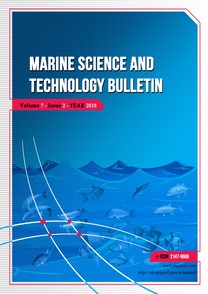Characterization, Identification and Phylogeny of the Creatine Kinase (ckma) Gene in Medaka (Oryzias latipes)
Creatine kinase (ckma) has been characterized and described in the medaka (Oryzias latipes), an aquatic model organism and the gene structure has been designed using the exons, introns, produced amino acids of the gene, TATA box, poly A tail and 5’ UTR and 3’ UTR regions of the ckma gene. In another step, firstly, the chromosome region of the ckma gene was determined in medaka and then the other genes which placed in the same region were determined. Then the locations of these genes were determined in zebrafish and human which are the orthologs of medaka. Finally, the conserved gene synteny was designed manually, using these data. However, genetic identity and similarity ratio between medaka and its orthologs were calculated. In this study, characterization and identification, phylogenetic relationship, conserved gene synteny of ckma gene in medaka (O. latipes) which is an important model organism were analyzed by using bioinformatics tools (NCBI database, Ensembl genomic database, Expasy, Reverse Complementary and some programs such as MEGA6 program, BLOSUM62 matrix program and BioEdit software). All these data will be used in future studies on molecular stress response in fish and they were presented to the scientific world with this study.
Keywords:
Medaka Genomic organization, Model organism, Bioinformatics,
___
- Amores, A., Force, A., Yan, Y. L., Joly, L., Amemiya, C., Fritz, A., Ho, R. K., Langeland, J., Prince, V. & Wang, Y. L. (1998). Zebrafish hox clusters and vertebrate genome evolution. Science, 282(5394): 1711-1714. https://doi.org/10.1126/science.282.5394.1711
- Arslan, H. (2015). Pestisit sinerjisinin; gökkuşağı alabalıklarında (Oncorhynchus mykiss) yüzme performansı, biyokimyasal hematolojik, histopatolojik ve genotoksik etkilerinin araştırılması. Ph.D. Thesis. Atatürk University, Erzurum, Turkey.
- Basu, S., Binder, R. J., Suto, R., Anderson, K. M. & Srivastava, P. K. (2000). Necrotic but not apoptotic cell death releases heat shock proteins, which deliver a partial maturation signal to dendritic cells and activate the NF-kappa B pathway. International Immunology, 12(11): 1539-1546. https://doi.org/10.1093/intimm/12.11.1539
- Braasch, I. & Postlethwait, J. H. (2012). Polyploidy in fish and the teleost genome duplication (pp. 341-383). In: Soltis, P. S., Soltis, D. E. (eds.), Polyploidy and Genome Evolution. Springer. 420p. https://doi.org/10.1007/978-3-642-31442-1_17
- Collins, F. S., Patrinos, A., Jordan, E., Chakravarti, A., Gesteland, R. & Walters, L. (1998). New goals for the U.S. human genome project: 1998-2003. Science, 282(5389): 682-689. https://doi.org/10.1126/science.282.5389.682
- Çapan, E. C. (2019). Plati balığı (Xiphophorus maculatus)’nda katalaz enzim geninin biyoenformatiği ve doku spesifik dağılımı. Master Thesis. Atatürk University, Erzurum, Turkey.
- Hori, H. (2001). A glance at the past of medaka fish biology (pp. 1-16). In: Naruse, K., Tanaka, M., Takeda, H. (eds.), Medaka: A model for organogenesis, human disease, and evolution. Tokyo: Springer. 387p. https://doi.org/10.1007/978-4-431-92691-7_1
- Ishikawa, Y. (2000). Medakafish as a model system for vertebrate developmental genetics. BioEssays, 22(5): 487-495. https://doi.org/10.1002/(SICI)1521-1878(200005)22:5%3C487::AID-BIES11%3E3.0.CO;2-8
- Iwama, G. K., Vijayan, M. M., Forsyth, R. B. & Ackerman, P .A. (1999). Heat shock proteins and physiological stress in fish. American Zoologist, 39(6): 901-909.
- Jacquet, C., Thermes, V., de Luze, A., Puiseux-Dao, S., Bernard, C., Joly, J. S., Bourrat, F. & Edery, M. (2004). Effects of microcystin-LR on development of medaka fish embryos (Oryzias latipes). Toxicon, 43(2): 141-147. https://doi.org/10.1016/j.toxicon.2003.11.010
- Kan, B., London, I. M. & Levin, D. H. (1988). Role of reversing factor in the inhibition of protein synthesis initiation by oxidized glutathione. Journal of Biological Chemistry, 263(30): 15652- 15656.
- Kell, A. J. E., Yamins, D. .L. K., Shook, E. N., Norman-Haignere, S. V. & McDermott, J. H. (2018). A task-optimized neural network replicates human auditory behavior, predicts brain responses, and reveals a cortical processing hierarchy. Neuron, 98(3): 630-644.e16. https://doi.org/10.1016/j.neuron.2018.03.044
- McLean, L., Young, I. S., Doherty, M. K., Robertson, D. H. L., Cossins, A. R., Gracey, A. Y., Beynon, R. J. & Whitfield, P. D. (2007). Global cooling: Cold acclimation and the expression of soluble proteins in carp skeletal muscle. Proteomics, 7(15): 2667-2681. https://doi.org/10.1002/pmic.200601004
- Meyer, A. & Schartl, M. (1999). Gene and genome duplications in vertebrates: The one-to-four (-to-eight in fish) rule and the evolution of novel gene functions. Current Opinion in Cell Biology, 11(6): 699-704. https://doi.org/10.1016/s0955-0674(99)00039-3
- Naruse, K., Fukamachi, S., Mitani, H., Kondo, M., Matsuoka, T., Kondo, S., Hanamura, N., Morita, Y., Hasegawa, K., Nishigaki, R., Shimada, A., Wada, H., Kusakabe, T., Suzuki, N., Kinoshita, M., Kanamori, A., Terado, T., Kimura, H., Nonaka, M. & Shima, A. (2000). A detailed linkage map of medaka, Oryzias latipes: Comparative genomics and genome evolution. Genetics, 154(4): 1773–1784.
- Postlethwait, J. H., Woods, I. G., Ngo-Hazelett, P., Yan, Y. L., Kelly, P. D., Chu, F., Huang, H., Hill-Force, A., Talbot, W. S. (2000). Zebrafish comparative genomics and the origins of vertebrate chromosomes. Genome Research, 10(12): 1890-1902. https://doi.org/10.1101/gr.164800
- Shima, A. & Mitani, H. (2004). Medaka as a research organism: past, present and future. Mechanisms of Development, 121(7-8): 599–604. https://doi.org/10.1016/j.mod.2004.03.011
- Stryer, L. (1995). Biochemistry (4th Ed.). New York: W.H. Freeman and Company. 1064 p.
- Thompson, J. D., Higgins, D. G. & Gibson, T. J. (1994). CLUSTAL W: Improving the sensitivity of progressive multiple sequence alignment through sequence weighting, positions-specific gap penalties and weight matrix choice. Nucleic Acids Research, 22(22): 4673-4680. https://doi.org/10.1093/nar/22.22.4673
- Yamamoto, T. (1953). Artificial sex-reversal in the genotypic males of the medaka, Oryzias latipes. Journal of Experimental Zoology, 123(3): 517-594. https://doi.org/10.1002/jez.1401230309
- ISSN: 2147-9666
- Yayın Aralığı: Yılda 4 Sayı
- Başlangıç: 2012
- Yayıncı: Adem Yavuz SÖNMEZ
Sayıdaki Diğer Makaleler
Pervin Vural, Emel Özcan Gökçek, Sefa Acarlı, Bilge Karahan, Evren Koban Baştanlar
Emre Özer, Selçuk Berber, Sefa Acarlı
Yunus Emre ÖZER, Sefa ACARLI, Selçuk BERBER
Can EYTEMİZ, Faik Erdeniz ÖZEL
Faik Erdeniz Özel, Can Eytemiz
Additional Record of Hemiramphus far (Hemiramphidae) in Northern Aegean Sea (İzmir Bay, Turkey)
Okan Özaydın, Özlem Güleç, Zafer Tosunoğlu, Ahmet Mert Şenbahar
